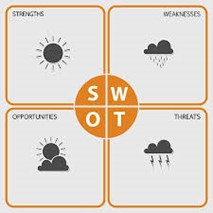Top tips for decision-making in business (Part 2)

This is the second part of a two-part article, read the first part.
Decision-making tools
There are lots of different strategies and variations on a theme as a simple Google search will prove. I’ll focus here on five techniques I believe will prove helpful in most situations:
- SWOT analysis
- Pros and cons
- Reverse brainstorm
- “5 whys”
- Cost/benefit analysis
SWOT Analysis

One of the classic processes to help you consider your options is the SWOT analysis - strengths, weaknesses, opportunities, threats.
Strengths
What advantages do you have? What do you do better than others? What do others see as your strengths? Why do your customers buy from you? What are the characteristics of your business?
Weaknesses
What areas could you improve upon? What do others see as your weaknesses? What loses you sales? Think of this from both internal and external perspectives.
Opportunities
What trends are you aware of? What market opportunities are there you’ve not taken advantage of? Think of changes in technology, or social patterns, you could embrace. Think of any other factors that may affect your market that you could use to your advantage. Consider whether any of your strengths may be further developed into opportunities.
Threats
What obstacles do you face? What are your competitors doing that may have a negative impact on your business? How easy could it be for someone else to do what you do? In other words, what is the cost of entry? If the cost of entry is low, then you could easily face new competitors. Are industry standards changing? Are developments in technology leaving you behind? Could any of your weaknesses seriously threaten your business?
SWOT provides you with a great understanding of your business.
Pros and Cons
This is an old standby and a very simple format to use. Effectively you start with a blank sheet of paper (flipchart or whiteboard) with two columns, the left headed “Pros” and the right “Cons.”
Take a separate sheet for each option in your process and work through all the benefits and downsides for each. Be brutally honest and put everything down.
When you review the results, you may need to “weight” each of them as some may have more significance or value than others. They may have a greater cost, or perhaps lead to a significantly different outcome.
Reverse Brainstorm
Now this is one of my favourites! I’ve successfully used it in sales team and customer service training to significant effect.
You’ll be aware of normal brainstorming where everyone is involved in a “brain dump” of ideas around a topic. Everything is considered and no judgment is made at this initial stage.
So, what is the difference with reverse brainstorming? Probably it is best to give you a couple of examples. The first is related to a fall in sales and an investigation into what was going wrong.
The question posed was:
What can we do to ensure we lose sales?”
Yes, you’ve guessed it—reverse brainstorming involves asking the opposite to what you want to achieve!
The assembled sales team then starts to give examples:
- Turn up late for customer meetings
- Don’t answer the phone
- Don’t get quotations in on time
- Don’t follow up quotations
The amusing thing is that light bulbs start to turn on as individuals begin to realise, they are guilty of some of these. The important thing is that these issues, reversed, give you the solution!
I used the same tactic for retail staff in a business that was suffering from lower than acceptable levels of customer service.
The question posed in this case was:
What can we do to ensure customers never come back to shop with us?”
This resulted in some off-the-wall answers:
- Don’t open the store on time
- Be rude to customers
- Keep the store dirty and untidy
- Take long breaks
- Leave the store unattended
- Ignore customers and keep chatting
You get the idea.
Sometimes it is easier to think of the downside of a situation (the negatives) than to think of the upsides (the positives). This process can help you unblock minds if you are struggling with ideas on how to solve a problem.
You may choose therefore to use reverse brainstorming as an ice-breaker or warm-up process before getting into the more detailed stuff.
“5 Whys”
“5 Whys” is an iterative process used to get to the true underlying cause of a situation.
If you are familiar with the Six Sigma process, you will have come across the “5 Whys” in determining the root cause of a failure.
Let’s use a simple example we’ve probably experienced ourselves or know someone who has.
You are driving home from work, and your car stops.
The engine stops running! You are out of fuel!
- Why did your car stop?
- It was out of fuel.
- Why did it run out of fuel?
- Because I didn’t fill it up on the way to work this morning.
- Why didn’t you fill up this morning?
- Because I didn’t have time.
- Why didn’t you have time?
- I was late leaving home.
- Why were you late leaving home?
- Because I overslept.
You can probably tell from this example that you could actually keep asking ‘why’ until you uncover why you were late up (forgot to set the alarm or late to bed the night before).
The point is that “5 Whys” is not a fixed number. You may get to the underlying issue in 3, 4, or even 6 or 7 “whys.”
It doesn’t matter, 5 is just the average.
The main point is that you must uncover the root cause of the problem.
There are many theories about where the “5 Whys” originated, but Wikipedia attributes mainstream usage to its adoption by the Toyota Motor Corporation.
Ricardo Semler, the extraordinary head of SEMCO, uses “3 Whys” and extends their use to cover goal setting as well as decision-making.
The simplest way to use this is to get your key team in a room. Using a whiteboard is particularly useful. Start by writing the problem to be resolved and ensure everyone fully understands it.
Start asking why and ensure you distinguish causes rather than symptoms. Pay attention to the cause–effect relationship. Make sure that if you reverse the thinking you can retrace your steps back to the original question.
Take the entire process step by step and don’t try to jump to conclusions. Assess the process, not the people involved. It is never satisfactory to end with “human error” as the root cause as there must be a further cause—a lack of training, for example.
The “5 Whys” is not a universal panacea and will need to be used in conjunction with other processes.
Cost/Benefit Analysis
Cost/benefit analysis is a more systematic approach to estimating the strengths and weaknesses of alternative solutions, processes, and interactions. The purpose is to establish whether a course of action is financially sound—whether the benefits outweigh the costs, and by how much.
It also provides a basis by which you can compare the relative costs and benefits across different options. You may have come up with several alternative solutions to your problem—several different routes you could take.
By enlisting cost/benefit analysis of each of these options, you have a set of data for each. You can then compare and decide upon the optimum solution(s)—the best way forward where the benefits outweigh the costs.
You may wish to use this simple framework:
- Brainstorm the costs and benefits. Think also of on-costs and benefits, and indirect costs and benefits.
- Attribute a financial value to the costs. This can be resources, materials, or staff. Think of any ongoing costs that may be incurred in the future.
- Attribute a financial value to the benefits. This step may be a little harder as you may have to forecast potential revenues. There may be soft benefits that don’t have a direct financial value.
- Compare the resultant costs and benefits. This is where you first carry out a comparison of the values you have arrived at.
You may need to adopt a weighting process (as discussed elsewhere).
As I said at the beginning, these are just a few options you may consider when faced with the need to arrive at a decision.
Some of them may work better in specific sectors, whereas others may need to be utilized in conjunction with other tools rather than in isolation.
You will find processes that you are more comfortable with than others.
The most important message I wish to deliver is that when faced with a situation you must face up to it and make a decision!
While writing this I heard Tony Robbins say on the James Altucher Podcast:
Kill the monster while it is little. Don’t wait until it becomes Godzilla!”
How perfectly apt is that?
If you try to put off making a decision you are just allowing a situation to develop a life of its own. To fester. To undermine your business. To cause you an even bigger problem in the future.
Don’t just settle for short-term workarounds. They will come back and bite you at some point in the future. And believe me, it will always be at the most inappropriate and inconvenient time! A time when you have the most at stake. A time when setting a solution in place, in a rush, will inevitably be much costlier than if it were part of a planned process.
If you have a set of decision-making tools at hand, you will find the entire process a lot easier.
And more often you face up to making decisions, the easier the process becomes.
We don’t have 20:20 hindsight, not until it is too late anyway, so we should make valued, considered decisions based upon what we know at the moment.
Hopefully this article will help you with the ability to arrive at these decisions.
Author Bio | Keith Grinsted MBA FRSA

Born and bred in Essex (UK) and now living in Southend-on-Sea Keith has extensive experience across many sectors – private enterprise (startups, retail, and corporate), public sector (national and local govt), and third sector (Board Member and Trustee).
In the area of business turnarounds Keith has been referred to as a modern-day Sir John Harvey-Jones in the way he can look at a business and see opportunities the business owner has overlooked, or is simply unaware of.
He is a freelance business writer having written eBooks under his own name for Business Expert Press in New York and a blog for Huffington Post UK, as well as ghost-writing for others.
For the past three years he has campaigned against loneliness and isolation through his Goodbye Lonely programme, having had a conversation on BBC TV with the late Captain Sir Tom Moore. He has been regularly interviewed on TV, Radio, and in national papers and magazines.
He is highlighting the wellbeing of remote / hybrid workers who are not being cared for by their employers to the level they require. He is a Mental health First Aider, a Wellbeing Champion, and has had suicide awareness training.
Through his life experiences Keith is passionate about the issues individuals face when they must start their careers over again and often, perhaps, reinvent who they are. Hence his award-winning LAUNCHPAD Programme helping those who are unemployed or facing redundancy get their career back on track.
- Open University Business School Alumni Award for outstanding contribution to society
- Investors in People Exceptional People Award for Community Engagement
The single most important thing he works on is uncovering what it is they are passionate about.
Keith believes that we are all capable of great things but we tend not to try new directions. Unless we release our emotions and uncover our passion, we will find setting a new course for the future very difficult. Keith strongly believes everyone should continue to learn and relate that learning to the work environment.
This has all come together under Keith’s new IKIGAI Coaching Programme (ICP) which is focused upon using this Japanese concept to help individuals, senior leaders, and business owners discover their ‘reason to live.’ Bringing focus, balance and direction into their lives.
Keith is a great connector of people and has over 21,500 followers on LinkedIn and runs his Charity UK group with over 48,500 members. He is also Partnerships Director for Membership World.
December 2023
Would you like to contribute an article towards our Professional Knowledge Bank? Find out more.
